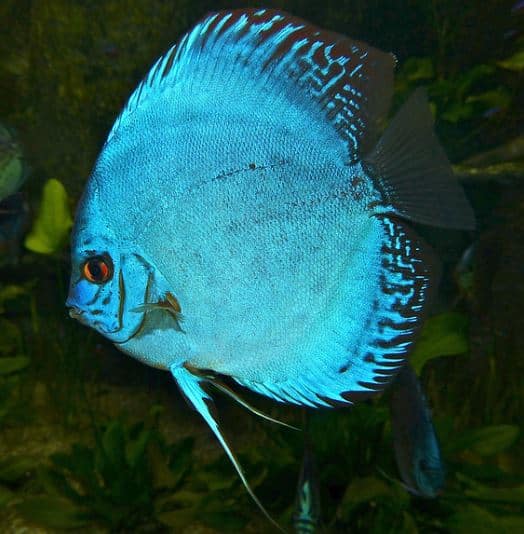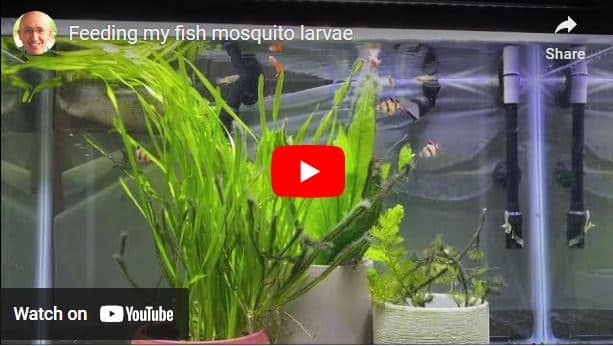How to Feed Your Fish Like a Pro: 9+ Foods They’ll Love
Ready to level up on what to feed your fish?
Information On Aquarium Fish Food Types
Having an aquarium can be a gratifying experience, but keeping your fish healthy can be challenging. It’s a big responsibility because your fish depend on you to provide the food they need to thrive. And if you’re just starting in fish keeping, there’s a learning curve figuring out what to feed your fish.
Fortunately, we’ve put together this ultimate guide to aquarium fish food types. From dry fish food feeder fish and herbivores to carnivore fish, it’s filled with everything you need to know.
How Much and How Often Should Fish Be Fed?
How much to feed a fish depends on its size, species, and testing. The basic fish-feeding rule is to only feed a fish what it can fully consume in 2 to 5 minutes.
Underfeeding your fish is better than overfeeding them, as most fish can survive 4 to 7 days with no food at all.
As mentioned earlier, herbivores do not have a stomach. Because of this, they graze all day long in the wild. In a tank, they will need to be provided with live plants to graze on as well as being fed several smaller portions throughout the day. Carnivores and omnivores on the other hand will only need to be fed once or twice per day with small portions.
You will want to avoid overfeeding your fish. While most fish will keep eating if you continue to feed them, overfeeding leads to many problems.
Overfeeding can pollute the fish tank, which in turn will cause sickness in your fish. A lot of fish can die directly from overfeeding. Some will become bloated and too heavy to swim. They will lie at the bottom of the tank, developing swim-related problems.
Image at the top of this page: An African chiclid. A freshwater aquarium fish.
Dry Fish Food
If you’re like most people, dry fish flakes are the first thing you think of when someone asks you to care for their fish. But there’s so much more to dry fish food than flakes! Keeper reading to learn more about the different types of dry fish food and what makes those colorful flakes.
Types of Dry Fish Food
The most common food people think of when feeding aquarium fish is dry fish flakes. Dry fish food also comes in pellet and granule forms that can be sinking or floating foods.
If you use dry fish foods, you risk not feeding your fish enough fiber. These foods need to be supplemented with vegetable foods to prevent swim bladder and bloating in vegetarian species.
Very thin pieces of fish food ingredients that have been processed into flakes. Fish flakes consist of ingredients like fish and shrimp meals, spirulina, minerals, and vitamins.
→ Fish crisps
These are a denser version of flakes that provide these upgrades:
-
-
- They float longer
- Feed cleaner
- Hold onto their nutrients longer
-
Note: If your fish’s mouth is too small to eat the crisps, you can break them up before dropping them in your aquarium.
→ Fish pellets
These are tiny to large balls or sticks that can float or sink, depending on your purchase type. They include ingredients like fish and shrimp meals, spirulina, minerals, and vitamins. There are floating pellets, slow-sinking pellets, and fast-sinking pellets.
→ Stick-on tablets
These are cleaner than flakes, crisps, and pellets because you simply stick the tablet onto the glass, and your fish feed from it. They contain proteins, vegetables, vitamins, and minerals.
→ Wafers
These are larger, disk-like food that slowly sinks to the bottom of the tank to soften. Once softened, your fish will nibble at it until gone. Wafers are typically packed with protein and vegetables, making them an excellent meal for bottom-feeding fish.
Dry Fish Food Ingredients
The most common ingredients in dry fish food are:
-
-
-
- Fish meal
- Shrimp meal
- Squid meal
- Earthworms
- Spirulina
- Vitamins and minerals
-
-
Why these ingredients?
→ Fish meal?
Fish meal provides Vitamin B, protein, and energy. It is made with fish that are typically not consumed by humans, and they are high in bone density and oil content. The fish are cooked, pressed, dried, and then ground up.
→ Shrimp meal?
Shrimp meal provides protein and functions as a natural laxative. It is made from shrimp unused shrimp byproducts that is not decomposed. The shrimp waste is dried out, ground up, and then mixed with the other ingredients.
→ Squid meal?
Squid meal is a source of vitamins, minerals, cholesterol, and amino acids. Squid meal comes from the internal organs of the squid that were discarded at food processing plants.
→ Earthworms?
Earthworms are a nutritious source of carbohydrates, fat, protein, and vitamins and minerals. They are dried, ground up, and added to the other ingredients.
→ Spirulina?
Spirulina is blue-green plankton. It is loaded with vitamins and minerals, providing your fish with an immune system boost. It contains beta carotene, and Vitamins A, C, E, and several B vitamins.
Fish food also contain an added variety of vitamins and minerals. The most commonly included are:
Vitamins E, B, and C
Riboflavin
Zinc
Biotin
Niacin
Manganese
There are a variety of other ingredients added to fish food, including wheat flour, paprika, soy, and food coloring.
Keeping fish can be costly, but there's a great way to offset those expenses.
Consider creating your own income producing website, just like I did with this one! I advertise Divi website creator, but you could place other ads on your website.
I've used Divi Wordpress website builder to build this site, and it's incredibly user-friendly. With its drag-and-drop interface, creating your own website becomes a breeze.
Simply tap this box to get started and see how easy it is to create a website with Divi.
The cost is $89/year. This is $7.41 per month. Divi comes with a 30 money-back guarantee. Try it at no risk.
Take this box to visit the Divi website to learn more. The link opens in a new window.
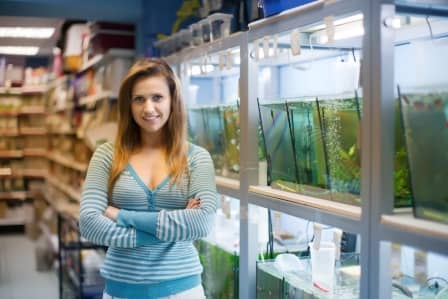
* Great Video: How to make a Website | Divi Tutorial 2024
Frozen Fish Food
Frozen fish foods are premium-grade foods with high levels of good-quality protein, fatty acids, and vitamins. They usually contain whole ingredients that have been flash-frozen to preserve the original nutrients and destroy as many pathogens as possible.
→ No Bloodworms!: Let’s get this out of the way. Bloodworms kill aquarium fish. Bloodworms have a shell which is difficult to digest. Don’t feed you fish bloodworms.
→ Frozen brine shrimp: Some fish require more fiber in their diets to prevent bloating and constipation. To add more roughage to their diet, you can feed them frozen brine shrimp. The brine shrimp’s exoskeleton consists of tough chitin, which is not digestible by most animals. For this reason, it will act as fiber for your fish.
→ Daphnia and Cyclops: Smaller fish will require smaller frozen foods, which is where frozen daphnia and cyclops come in. These tiny crustaceans are a source of protein and, because of their tough exoskeleton, help with smoother digestion.
→ Frozen baby brine shrimp Frozen baby brine shrimp are recommended for baby fish as they still have their yolk sac attached, and it is full of healthy fats and proteins that are perfect for newborn fish.
→ Mysis shrimp, krill, silversides and frozen feeder mice: Bigger fish require larger food options like Mysis shrimp, krill, and silversides. If you have giant fish, you may need to shop at the grocery store for human-sized food, such as prawns, cocktail shrimp, and fish filets.
How to feed your fish frozen fish food
You can drop the frozen cube directly into the tank, where it will quickly defrost, and your fish can begin eating on it. An alternative is to place the cube into a worm feeder cone to prevent larger or faster eating fish from consuming the whole thing before the other fish have a chance.
Another method is to defrost the cube in a small jar of tank water for a few minutes and then feed the water with a pipette to the fish.
Have a picky eater who will only take frozen or live food?
I recommend thawing the frozen cube in a container (without water) then mixing in a few drops of liquid vitamin supplements.
Regardless of which method you use, do not leave the frozen food out at room temperature for over 30 minutes because it may begin to spoil and smell. Do not refreeze any food that has been left out at room temperature because the bacterial growth process has already begun.
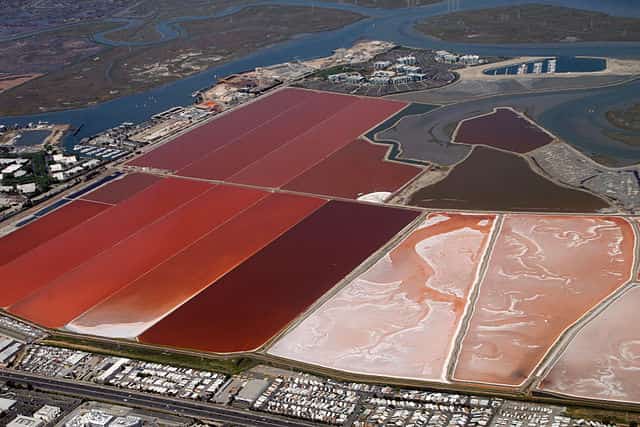
Picture above: San Francisco Bay Brand Brine Shrimp growing ponds. The shrimp will be harvested and frozen or dried and then sold to the hobbyist. This picture was taken by Doc Searls provided by Wikipedia and Wikimedia.
Farlowella: For When Regular Plecos Just Aren't 'Pleco-y' Enough
(Or maybe: The fish from outer space)
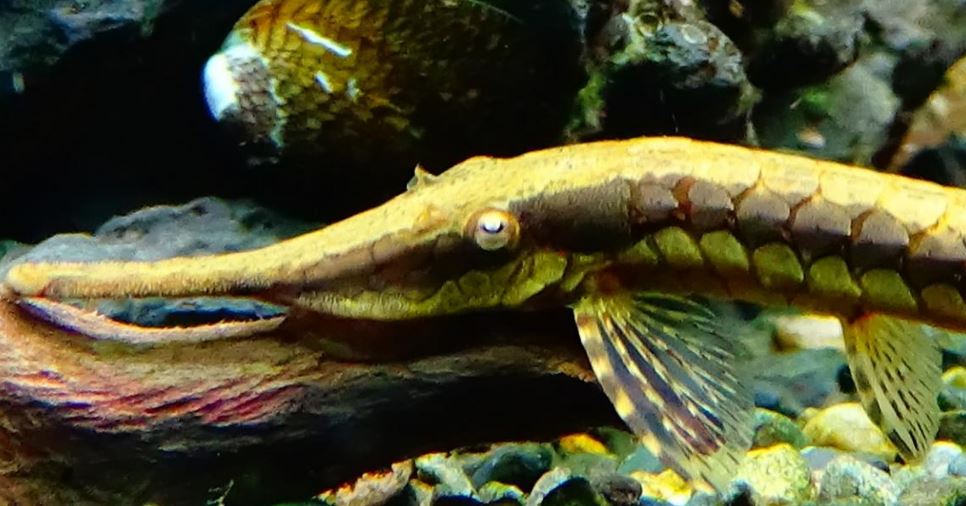

Freeze-Dried Fish Food
Freeze-dried foods typically contain one protein ingredient, such as bloodworms or shrimp. The same organisms used to make frozen fish foods are used to make freeze-dried fish foods. This type of food comes as convenient chunks. Here is an interesting food I haven’t tried yet. (amazon link)
Freeze-dried fish foods do not make a complete diet for your fish, and it works best in combination with other fish foods, like flakes.
The process of freeze-drying strips the food of its nutrients. This type of food is mostly air, meaning it cannot be relied upon to be the primary food source for your fish. It can be a snack or treat that you feed them occasionally.
Some of the most popular freeze-dried fish foods are:
-
-
- Brine shrimp
- Tubifex
- Daphnia
- Blackworms
- Krill
-
Freeze-dried food has a long shelf life and can be crumbled up for smaller-mouthed fish.
Fish Food for Herbivores, Carnivores, and Omnivores
Did you know fish are further categorized as herbivores, carnivores, or omnivores? This categorization determines the food your fish will eat.
All three types of fish require supplements to ensure their nutritional requirements are met. These include Vitamin B1 to break down carbohydrates, Vitamins B2 and B6 to help with enzymes, and Vitamin C to promote digestion, bone development, and healing. They also require calcium, manganese, and phosphorus.
→ Herbivores
Herbivore fish are plant eaters, meaning they consume a lot of fiber, which is indigestible. To handle indigestion, their digestive tracts are much longer than carnivores. They do not have a true stomach and instead, their intestine breaks down their food.
They eat a diet that consists of plants, fruits, vegetables, and algae. They have flat teeth that help grind up their food before they swallow. There are very few genuinely herbivorous fish in the world.
To feed your herbivores, start by placing live plants and algae in your tank. However, you cannot rely on these two to feed these fish alone, so they should be given algae wafers and flake food for herbivores.
Your fish can also eat blanched (lightly cooked) vegetables like spinach, zucchini, lettuce, and peas or small amounts of fruit like apples and pears.
You may also have to provide your herbivores with vitamin and mineral supplements.
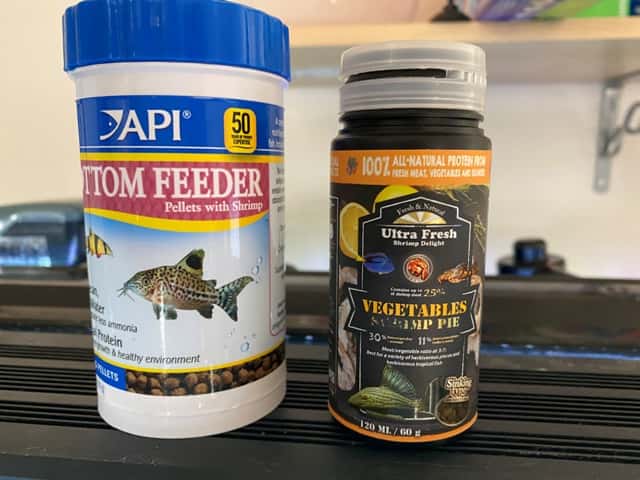
→ Omnivores
Omnivore digestive tracts have characteristics of herbivores and carnivores, allowing them to consume both plant and animal matter. They are the easiest type of fish to care for because they can eat any foods suggested for herbivores and carnivores.
Omnivores can eat anything an herbivore or carnivore can eat. However, they do not require the same amount of protein as carnivores. Instead, their diet should have a maximum of 40% protein.
→ Carnivores
Carnivores require a high-protein diet that is full of meat. Carnivore fish typically have a larger mouth with pointed teeth. Their diet should include 45 – 70% protein. Besides protein, they require some fats and some carbohydrates.
Tubifex worms, white worms, and micro worms are an excellent source of protein and are available in live and frozen forms. Worms can carry disease, so they should be rinsed thoroughly and observed in another tank for several days before feeding to your fish.
Live, frozen, and cooked fish are also an option. Some carnivores are hunters, so offering live fish will allow them to hunt and get exercise.
Most meats are not a good choice for your fish because they are high in fats. Beefheart is the exception to this rule, once the excess fat is trimmed off. Feed Beefheart as a rare treat.
Dried food and supplements are also an option for carnivore fish.
Tiger Barb Care

Live Fish Food
Live foods can introduce disease and sickness into your tank because of how they are sourced. The best option is to keep them in a separate tank and monitor them for a few days to a week to ensure that they are healthy enough to feed your fish.
Common live fish foods are:
Artemis brine shrimp
Tubifex worms
Daphnia
Many types of popular live foods can be grown at home, letting you have a ready supply of fresh, healthy food.
Here is an article I wrote about growing 7 live foods at home + a recipe for creating fish food. Opens in a new tab/window.
For large predatory fish, consider using feeder fish. Some fish only eat other fish, which is the only method of feeding them. These are fish that have been bred and raised for the sole purpose of feeding other fish.
Be aware: There is the potential to introduce disease into your tank with feeder fish. Feeder fish should be observed in a separate tank for a few days to a week to ensure it is safe to feed to your fish.
There are several reasons that your fish may require live fish food:
* Wild-caught fish, for instance, do not know of any kind of food except for living food. Because of this, they may not eat any alternative types of food. You may be able to wean them off live food slowly, but you will still need to provide it during the weaning process.
* Newly hatched fry will, as an instinct, identify a wiggling live food as something to eat. While fry will need to learn to eat other kinds of food, it may be easiest for them to start with live foods. Additionally, dry foods may be too large for the newborns’ mouths, while live foods will be easier to eat.
* Adult fish may require live food to breed. Even if their nutritional requirements are met with dry food, they may need live food to convince them to produce.
Types of Live Fish Food
There are many types of live fish food, but some are more common than others.
Brine shrimp are saltwater shrimp that are available as eggs or Artemia cysts. They can be stored in dry, oxygen-free conditions for up to two years. They are easily hatched in just a few hours by placing them in salt water. Adult brine shrimp make great food for a variety of fish.
Daphnia are also known as water fleas. Two species, Daphnia pulex and Daphnia magna, are used as live foods for fish in the aquarium hobby and aquaculture.
Microworms are tiny nematodes. They are straightforward to grow, requiring only oatmeal and yeast. Because they are so easy to culture, they are one of the most common food sources for fry.
Tubifex worms have been a popular choice of live food for a long time. However, they are often harvested from unsanitary locations, as they are found in muddy sediments of rivers and lakes, ditches, and open sewers. If you choose to use Tubifex as a food source, you must find them harvested from a clean source.
Other live fish food options include:
-
-
- Banana worms
- California blackworms
- Copepod
- Duckweed
- Earthworms
- Feeder fish
- Gammarus shrimp
- Green water
- Grindal worms
- Infusoria
- Mealworms
- Microfex worms
- Moina
- Mosquito larvae
- Vinegar eels
- Walter worms
- White worms
- Fruit flies
-
You can find out more about growing live fish food here.
Video below: Early morning fish feeding – mosquito larvae
Opens in a new tab or window.
Farlowella: For When Regular Plecos Just Aren't 'Pleco-y' Enough
(Or maybe: The fish from outer space)


How should you feed your fish if you are going out of town taking a vacation?
When you go on vacation, you face this dilemma: who will feed your beloved fish?!
Slow-release feeding blocks to the rescue! They are small blocks that slowly dissolve, dispensing food into the water for your fish to eat.
It’s best to do a test run to ensure that your fish eat the food. Otherwise, you may return from vacation to find that the feeder has dissolved, making your water cloudy, and your fish ate none of it.
Slow-release feeders come in different flavors, ingredients, shapes, and sizes. This way, you will find one that will suit your fish. They come in two types: weekend feeders and vacation feeders.
-
-
- Weekend feeders will feed your fish for 3 days
- Vacation feeders will last for up to 14 days
-
You will need to select the brand and ingredients that best match the fish you have in your tank. You also need to ensure you have the correct amount of filtration and water movement. If you do not, you run the risk of the brick not dissolving correctly. Also, if you have too many fish, one brick may not sustain all of them.
You can purchase an automatic fish feeder and use your favorite dry food as an alternative. Simply set the timer, and your fish will receive their daily meal. (Amazon link)
Homemade Fish Food (with Recipes)
Making homemade fish food is cost-effective and straightforward. It is a great way to provide a healthy diet and tailor the foods to the specific dietary needs of your fish.
You will know where all of your ingredients are coming from. You can ensure that everything is sustainably sourced and provide only high-quality foods for your fish.
Common meat-based ingredients include beef heart, fish, shellfish, and worms. Common plant-based ingredients include peas, leafy greens, and chopped or shredded vegetables.
To make your homemade fish food, you will need the following:
-
-
- Ingredients
- Blender
- Kitchen scale
- Knife
- Pan
- Freezer
- Ice cube trays
- Plastic wrap
-
Homemade food recipes are effortless to follow. Here are several that you can try today.
Homemade Gelatin Fish Food Recipe
One of the most common and quickest homemade food recipes, this homemade fish food can be prepared and stored in the freezer.
Ingredients
-
-
- 2 sachets of unsweetened gelatin
- 3 cups of vegetables
- ½ cup seafood (shrimp, fish, clams, etc.)
- ½ clove garlic
- One drop of fish vitamins
-
Directions
Cut and cook all vegetables.
Puree vegetables, garlic, and seafood together until the consistency is mushy. Add the drop of vitamins.
Boil water for the gelatin. Add the amount according to the directions on the packet. Add the gelatin to the vegetable puree.
Pour the mixture into ice cube trays or large zip lock plastic bags. Store in the freezer until you need to use it.
No-cook Fish Food Recipe
As the name implies, there is no cooking involved with this recipe.
Ingredients
-
-
- Peas – 75g
- Spinach – 75g
- Cucumber – 75g
- Cod – 75g
- Shrimp – 75g
- Gelatin – 268g
-
Directions
Chop all ingredients into fine pieces. Grind them together into a paste and add some water.
Prepare the gelatin in a separate container, then add it to the paste. Mix well.
Pour the mixture into ice cube trays and store in the freezer until needed.
Meaty Fish Food Recipe
Perfect for most fish, this food is full of protein and meat.
Ingredients
- Vegetables
- Unflavored Gelatin
- Beefheart
- Whitefish
- Shrimp
Directions
Cook and blend vegetables into a smooth consistency.
Shell the shrimp. Blend Beefheart, whitefish, and shrimp together.
In a separate container, prepare gelatin according to directions on the packet.
Combine all ingredients. Pour mixture into ice cube trays or plastic ziplock baggies and store in the freezer until needed.
The Bristlenose Plecostomus: A Quirky Addition to Your Aquarium
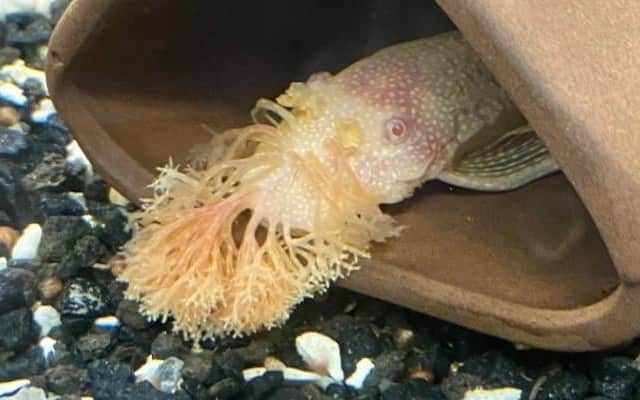
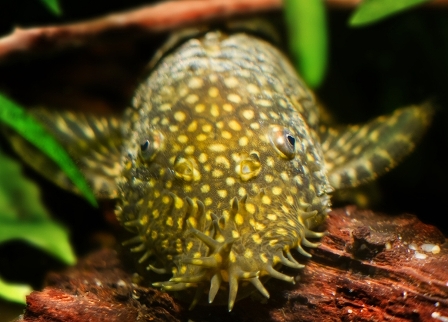
Fresh Foods to Feed Your Fish
Even though they grow on land, vegetables can be part of your fish’s diet. Whatever vegetable you decide to feed them, you must make sure that it is washed and dried. Some vegetables will have to be blanched, while others will be steamed. Very few vegetables can be fed to your fish raw. Part of the reason for this is that raw vegetables usually float on top of the water, making it impossible for some fish to find them.
The most common vegetables to feed your fish are carrots, cucumbers, zucchini, lettuce, and peas.
Cucumbers and zucchini can be fed to your fish raw as long as you remove the seeds first. The others will need to be cooked to be softened and then cut into smaller pieces before feeding them to your fish.
Broccoli, tomatoes, pumpkin, and potatoes are also all viable options to give to your fish. Some fruits, including bananas, melons, pears, and apples, can be given to your fish as well. However, any uneaten food must be removed as soon as possible to avoid negative effects on the water quality.

Canned veggies for my fish
You can turn your aquarium fish hobby into an income producing side hustle.
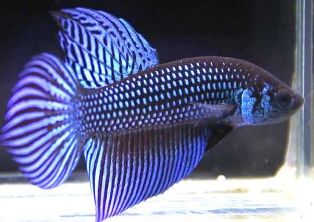
Create a website like mine to earn enough to buy aquariums, or fish, or equipment or if you work hard enough, retire from your 9 to 5.
I used "Divi" website creator to make this website. It costs $89/year (this comes out to about $7/month.)
Tap this ad to find out more.
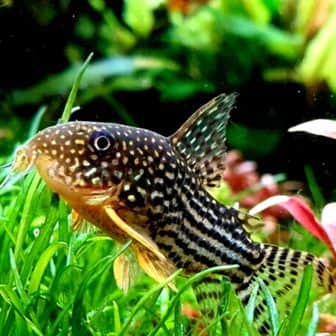
Aquarium Fish Food Types Recap
With all the different fish foods available, it can be overwhelming to decide what to feed your fish. The most important thing is choosing a food that best meets your fish’s nutritional needs.
Whether it is dry food, frozen food, or homemade food, you need to ensure that you choose food that is right for the fish you have.
FAQ About Fish Food and Feeding Fish
1. Question: “What is the best type of fish food?”
Answer: Live foods are best. Grow them yourself or frozen. I recently got a bottled liquid of mosquito larvae online. Amazon Link. My fish love them! So, live foods.
2. Question: “How long can a fish go without eating?”
Answer: As much as a week. Personally I don’t think I would do that to the fish because feeding blocks can be bought when the fish keeper is away.
3. Question: “How can you tell when aquarium fish are hungry?”
Answer: I have to be honest, I don’t think you can tell. Eating is what fish do best and they will eat whenever food is put in the tank. For me, I feed my fish 3 to 5 times a day. They seem to grow better when I am replicating how they eat in nature. That is several small meals a day.
5 steps you can take to stop your aquarium plants from dying
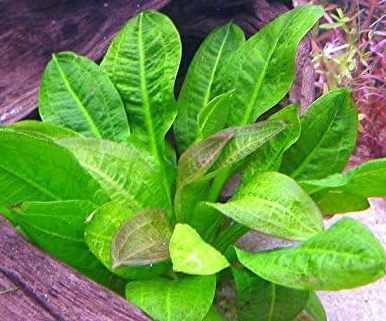
Other pages on this site:
* Freshwater Aquarium Plants You Can Grow
* 11 Exquisite, Effortless Aquarium Plants That Totally Won't Outgrow Your Tiny Fish Tank
* Discus Fish: Because Regular Fish Just Aren't Enough of a Challenge
* Planted Nano Aquarium Magic: Tricking Your Plants Into Thinking They're Happy (CO2-Free Method)
* How to Train Your Oscars: Because Fish Totally Respond to Commands Like Dogs
* What size aquarium should you get?
Discus
Discus Care
